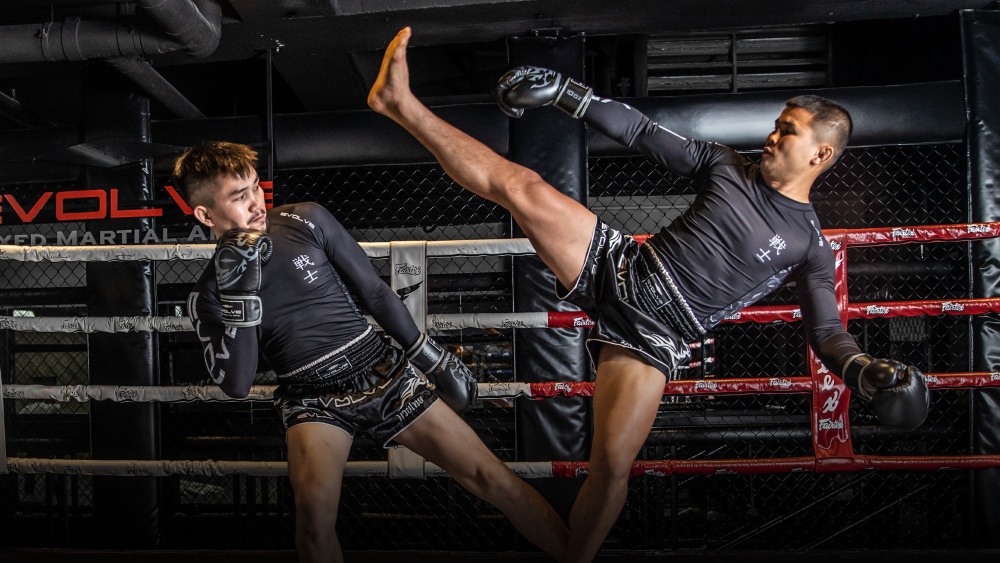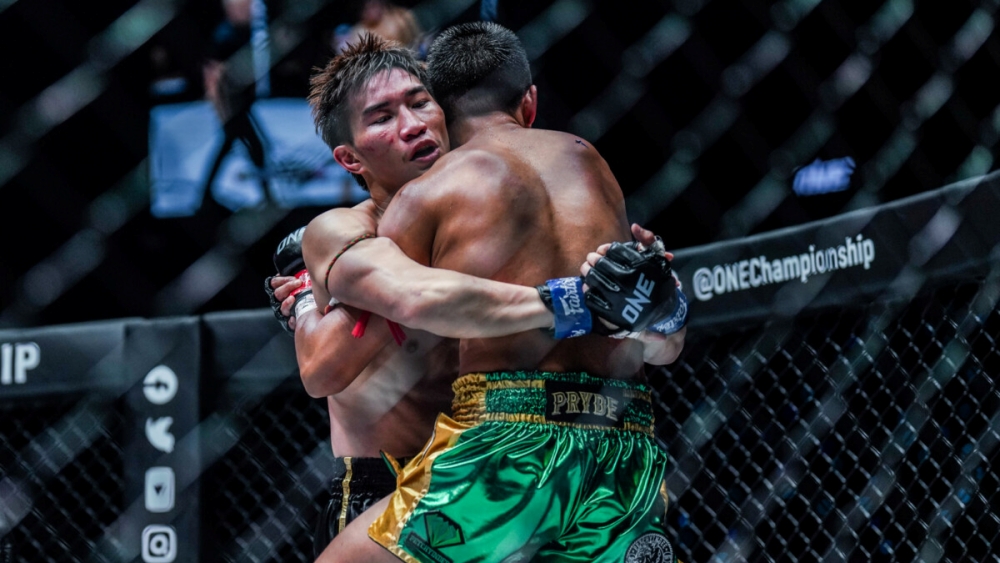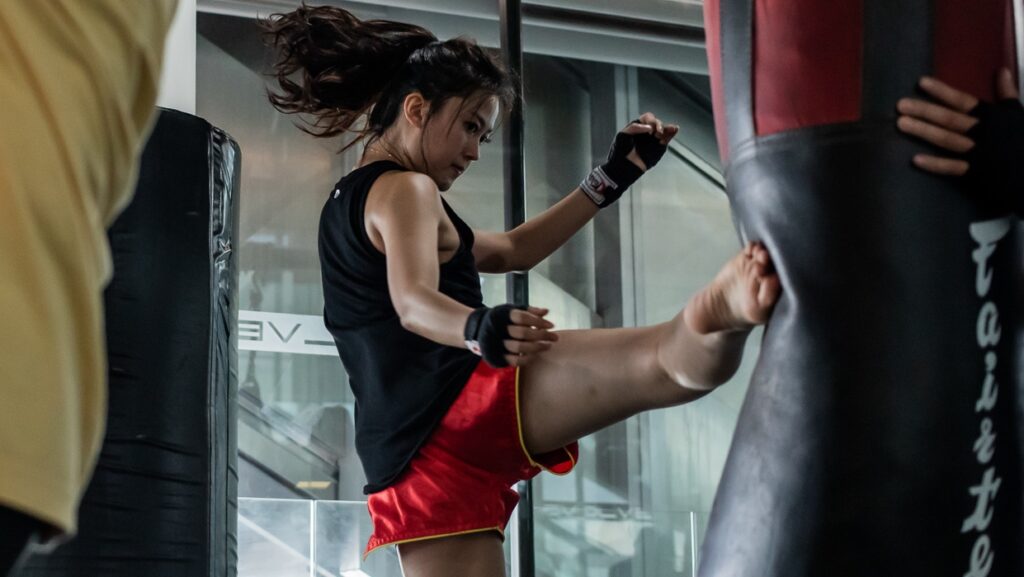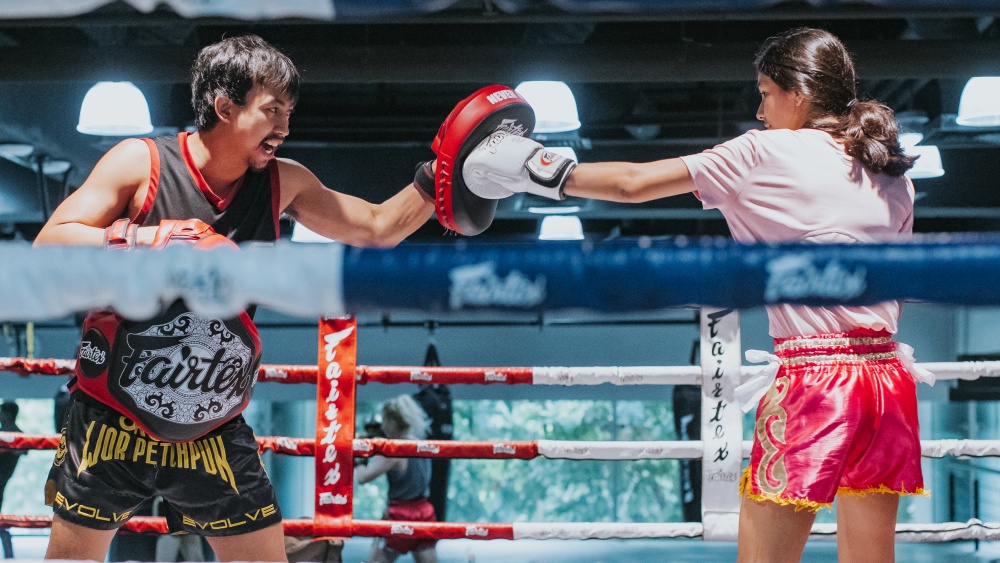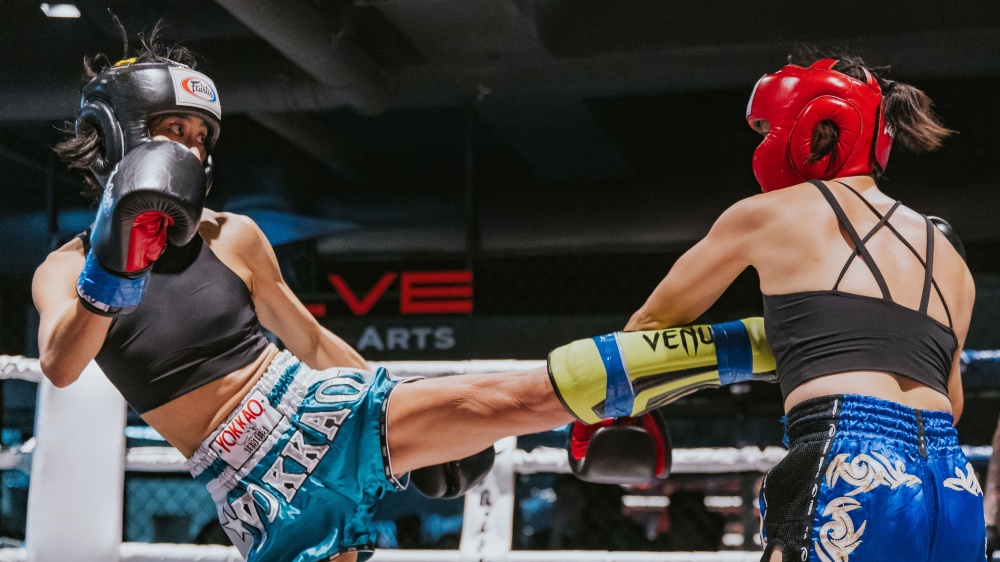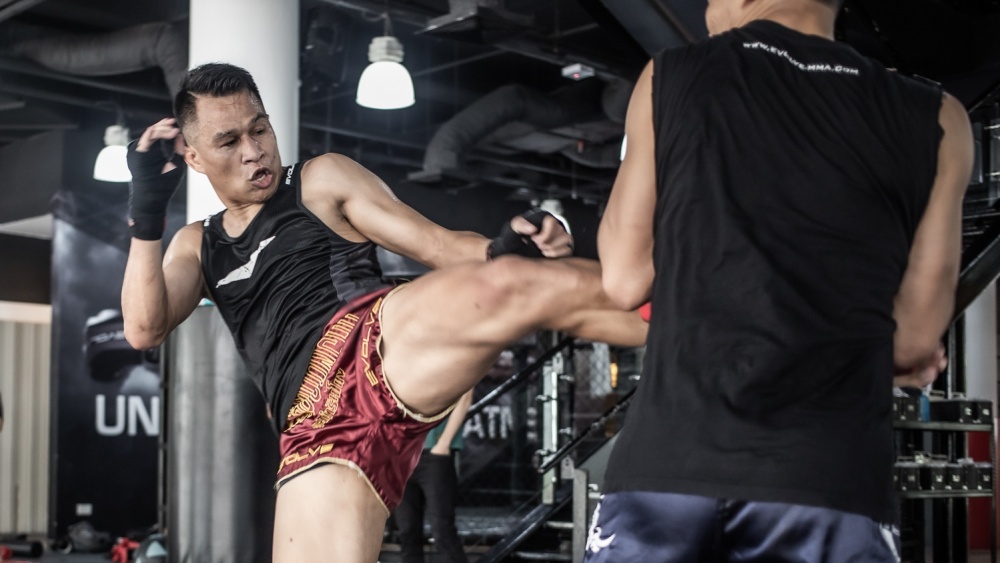Muay Thai is widely regarded as the most effective striking discipline on the planet. Also known as the “Art of Eight Limbs” (as competitors can use their fists, elbows, knees, and legs), Thailand’s national sport prides itself on being the most technically superior of the stand-up arts.
The world of Muay Thai may seem daunting for newcomers, but beginners will find a welcoming environment full of friendly coaches and training partners to help you along your journey through this iconic art – no matter how fit, strong, or athletic you are.
Anyone who takes a look at the world-class competitors who compete in the stadiums of Bangkok or organizations like ONE Championship might assume you need to be a true warrior to train in Thailand’s national sport. However, it won’t take long for novices to get to grips with its rules, learn to appreciate the beauty of its techniques and traditions, and even learn to emulate the heroes who step into the ring.
In this complete beginner’s guide to Muay Thai, you’ll learn all about how you can easily start to thrive on the Muay Thai mats – even if you’ve never thrown a kick in your life – and how you can get start enjoying one of the world’s most electrifying martial arts disciplines. From stances and footwork to the various strikes and styles found in the sport, allow us to take you on a journey through everything you need to know to get you up and running.
Chapter 1: Stance And Footwork
The first thing one needs when building a wall is a foundation. The fundamental component of a Nak Muay (Thai boxer) is their stance and footwork.
As such, we will start from the bottom and work our way up.
Stance
If you are new to this wonderful sport, a strong Muay Thai stance is the first thing that you will need to learn before anything else. It is crucial that you dedicate time to perfecting your stance, as everything else is built from this foundation.
In order to position yourself in the right way, you will need to start with your foot placement.
The instructions below will help you to achieve the required positioning (for a right-handed fighter) in a proper Muay Thai stance:
- Stand with both feet together.
- Lift your toes on your right foot.
- Pivot your right foot out to a 90-degree angle.
- Leaving your toes on the floor, lift the heel of your foot.
- Pivot your foot and place it back down so that your toes are pointing outward.
- Now, lift your toes up and rotate out to a 45-degree angle.
- Finally, lift up your heel and push your right foot straight back.
It is important that you have both heels off the floor when in your stance. This is because it gives you better balance and stability, which are crucial in Muay Thai.
In order to ensure you are in the right stance, you can take some tape and create a cross on the floor. Use two strips of tape – both equal in length – and place the horizontal strip through the middle of the vertical strip. This will create four “squares” that you can use to place your feet in.
Your lead foot should be in the upper left square while your rear should be placed in the bottom right square. This will help you to ensure that your stance is correct.
Posture
Once you have your stance in order, it is time to work on your posture.
In Muay Thai, your footwork and posture are crucial to your movement, both in attack and defense. While standing straight and tall, you should also have a slight bend in your knees to facilitate better movement. This also aids in generating power and torque as it allows your hips to rotate freely with the movement of your back foot.
Your posture should be tight with your lead shoulder in line with the heel of your lead foot. This will ensure that you are in the right position to attack, as well as defend yourself from any incoming shots.
The Guard
No one likes to block punches with their pretty face, right? After all, we have our good looks to preserve. As such, you will need to ensure that your guard is effective in keeping your opponent’s shots from landing and you protect yourself from being hit.
Unlike in boxing, where you usually tuck your chin into your chest at all times, your Muay Thai stance should be upright with your chin up but just slightly tilted down. This will allow you to see what is coming as it aids your peripheral vision.
Boxers only have to concern themselves with punches, whereas, in Muay Thai, a fighter has to protect themselves from kicks, knees, and also from being clinched. If you tuck your chin in, your head is down and pointing forward, which can leave you open to being grabbed and clinched.
When setting up your guard, you need your elbows pointing slightly outwards to the sides for protection:
- Make two solid fists by rolling your fingers and folding your thumbs at 90-degree angles over your index and middle fingers.
- Your forearms and elbows should be slightly out to the side.
- Hands should be up with lead arm level with the bridge of your nose and the rear hand level with your mouth.
- Keep your chin up but just slightly tilted down.
- Ensure your eyes are not obstructed and you can anticipate precursor movements from your opponents’ arms and legs.
- When throwing a jab, keep your rear hand protecting your chin in case your opponent throws a punch at the same time.
- Stay relaxed.
Some fighters prefer to keep their chins tucked in close to their chest, but this depends on the style of the fighter. For example, a Muay Mat (an aggressive, forward-moving fighter that relies on heavy punches and low kicks) might prefer this method but it is best to learn the proper stance before considering fighting this way.
Footwork
Good posture and balance will determine how smoothly you can move around the ring. This is why it is vital to ensure that your stance is correct at all times.
Your footwork will have a knock-on effect when it comes to the quality of certain aspects such as your overall movement, the power of your strikes, and your ability to defend yourself. When beginning your Muay Thai journey, it is important to remember to master the basics in stages, starting with your stance and footwork.
Using the tips above, ensure that your feet are not parallel or placed in front of one another. When stepping forward, push off the back foot and step forward with the lead foot. To retreat, step back with the rear foot pushing back with the lead foot. Your movement should be rhythmic and as smooth as possible, with an emphasis on never crossing your feet. To do so will compromise your balance.
As mentioned earlier, keeping your heels off the floor is crucial to your balance. Always keep the same distance between both legs – each shoulder should be in line with the heels of the corresponding foot.
Your rear foot is the one that you will pivot on when moving or trying to generate power for strikes. It is important to practice the movement of both feet as much as possible in order to feel comfortable enough to maneuver your body at your will.
Ensure that you spend your time perfecting your stance by practicing your movement inside a ring. You can do some shadow boxing or light sparring with a training partner to test the waters.
Always remember – practice makes perfect.
While many of the flashy and spectacular knockouts and stoppages in the sport come via deft kicks and slicing elbows, punches are often the precursor to the final nail, so to speak. A number of Muay Thai’s greatest fighters invested considerable importance in the use of the fists, with the likes of Samart Payakaroon, Veeraphol Sahaprom, Somrak Khamsing, Anuwat Kaewsamrit, Wanheng Menayothin, and Saensak Muangsurin enjoying success in Western Boxing.
Other than helping to set up combinations or even ending contests, fundamental boxing skills can also keep an opponent from moving into range. As Muay Thai is a discipline that requires combatants to be proficient with more than just their fists, you are unlikely to see the next Roy Jones Jr., Sugar Ray Leonard, or Vasyl Lomachenko cleaning up at the legendary Lumpinee or Rajadamnern stadiums. To discount the importance of honing your skills with your fists is a big mistake, however.
With that in mind, let’s take a look at the most important punches for a beginner to master in Muay Thai.
The Jab
There is no doubt that the jab is the most important punch in boxing and Muay Thai.
Yes, this punch is unlikely to knock an opponent out or earn a fighter a place in the highlight reel of the year. However, the jab has numerous uses and it is essential for any budding competitor to master. The jab takes little energy to throw and takes less time to land than any other punch. You should see it as the baton that an orchestra conductor uses to maintain the tempo of an arrangement.
As it is closest to the target, you can use the jab to feint, disrupt your opponent’s rhythm, and measure the distance between you and the other competitor. You can use the jab to set up another punch, such as a cross, or to draw your opponent’s attention and guard up in order to land a low kick. You can also use a jab to move your opponent into the path of a head kick. The jab is so important in Muay Thai.
When throwing a jab:
- Ensure your elbows are down and are tight with your rear hand protecting your chin.
- Push out with your lead hand, driving forward with your leg towards the target.
- In order to get the snap behind the jab, rotate your fist just before contact, keeping your elbow down until this motion.
- Ensure your jab comes straight back immediately, which will keep you protected against a counter shot through that open channel – this also helps the snap of the jab.
A strong, quick jab should be your go-to weapon, as it can set attacks up and leave you in a strong position once it has landed.
The Cross
Also known as a “straight” punch, the cross is the second fastest punch you can throw and one of the most utilized strikes in the sport and can be powerful enough to really cause your opponent trouble. As some combatants in Muay Thai pay more attention to kicks and knees than to punches, a cross can come in very handy in certain situations. Fundamentally, it is always a good weapon to have inside the ropes.
As a beginner, you will want to practice one-twos as much as possible before moving on to more advanced techniques. The “one” is your jab, and the “two” is your cross. You can use a heavy bag to perfect your technique, along with regular bouts of shadow boxing and mitt work with teammates or your coach.
The cross can be a show-stopping punch if timed right, but can also be built into combinations that set up kicks. The cross does not have to be thrown behind a jab, but can sometimes follow a feint or a low kick.
When throwing a cross:
- Ensure you are in a defensive stance with elbows down and your guard up and in range.
- When throwing the shot, fully extend your rear arm while pivoting your rear foot, leaning forward slightly, and bending your knees.
- Your body should twist anti-clockwise in this movement.
- Prior to the moment of contact, rotate your fist so your palm is facing downwards.
- Ensure your lead hand is protecting your chin from a counter shot.
- Pull the punch back straight away in order to get the snap and further protect yourself.
The Hook
You can throw a hook with either the lead or rear hand. This punch is a little more difficult to master but is certainly not something that should cause anyone who is dedicated to their technique much trouble. Speaking of trouble, if you land this shot on the opponent’s jaw, they could be in a whole heap of it.
The hook is certainly one of the four main punches when it comes to Muay Thai, so you should certainly invest some time in perfecting it. As with any technique, plenty of practice and drills are necessary when making it work for you. This punch is a sneaky one that can often catch an opponent off guard and even set you up for other strikes when they are stunned.
As a beginner, you should focus on the lead hook first. In order to master this technique, you should always:
- Start from your defensive guard.
- Keep your lead arm parallel to the floor with your elbow up and rear hand protecting your chin.
- Bend your knees and drop your shoulder.
- Pivot the lead foot, and rotate your hips and shoulders clockwise in order to generate power.
- Ensure that both feet are pointing to the right when you make impact.
- Don’t overextend or load up.
The Uppercut
The uppercut is an excellent shot to throw when in close range. However, getting it right is key to gaining the best results from this shot. As such, you will need to work hard on the technique and your timing to really make it work as, if either is not up to scratch, you could leave yourself vulnerable to elbow and knee strikes, and even open to being grabbed and clinched.
When throwing an uppercut, remember the following tips:
- Start from a defensive stance.
- Bend your legs and bring your shoulders down a tad.
- Ensure to protect your jaw and chin with the hand you are not throwing with.
- Drive up with your legs, forcing your arm through the target.
Even as a beginner, you may already be familiar with many Muay Thai kicks. In truth, there are fewer combat sports that can hold a torch to the spectacular nature of many kicks in the Muay Thai competitor’s arsenal of weaponry. One of Samart Payakaroon’s perfectly executed lead leg switch kicks was a thing of beauty, while a solid roundhouse kick to the body by Yodsanklai Fairtex would strike fear into the heart of any man.
However, when it comes to Muay Thai, a beginner should be aware that there are more to kicks than sublime attacks and highlight reel stoppages. Kicks can be used in a number of ways and for a variety of reasons, including both attack and defense.
Below, we will take a look at the most important kicks you need to know as a beginner in Muay Thai.
The Low Kick
An essential tool in any Muay Thai competitor’s arsenal, the low kick provides fighters with an exceptionally versatile tool. By targeting either the inner or outer part of your opponent’s leg, you can deliver a shot that is not only debilitating to their movement and balance but can also stop a fight.
In order to perfect the low kick, you will need to spend a lot of time practicing the mechanics and technique of how to throw it. There are a number of different types of low kicks which can be thrown against the lead or rear leg. The latter is certainly the most powerful, as it comes with a lot more power from your starting stance.
A few simple low kick tips include:
- Throwing the kick with your shin rather than your foot.
- Always keep your lead hand up when throwing the kick.
- When throwing the kick, take a small hop forward, landing with the toes of your lead leg pointing forward, pivoting on your lead foot.
- Swing your rear leg forward and in a downward motion, while whipping the rear arm down.
- Ensure to turn your hips, shoulder and head over for momentum.
The Body Kick
Head-hunters are often figured out very quickly in Muay Thai. As a result, going to the body is a necessary method for any fighter hoping to score points and keep their opponent guessing. Without the threat of body shots, an opponent will keep their guard up and walk into range safe in the knowledge that they will not suffer any punishment for their troubles.
The body kick, or mid-range roundhouse kick, is a shot that every budding Nak Muay should add to their toolbox. Not only can you cause damage to the opponent’s midsection with body kicks, but if you target their arms, you can also make it difficult for them to keep their guard up, thus creating an opening for headshots and potential stoppages.
Before you throw a mid-range roundhouse, there are few things to keep in mind:
- Make sure your balance is on point.
- Step forward and place the weight on your front foot.
- Whip your rear arm downwards while bringing the momentum forward.
- Drive your rear leg forward and towards the target (the ribcage is a common target in Muay Thai).
- As you move from stance to connecting your shin with the target, pivot on your front foot, turning your hip over in the process.
- Ensure that you reverse into a defensive stance and guard as soon as you have connected.
Switch Kick
A switch kick is one of those beautiful little techniques that can catch an opponent cold. The kick only works when you have honed the technique and can carry it through with fluency and accuracy. As always, your balance and flexibility must be strong enough to perform this strike, as poor execution can leave you in a vulnerable position where you can be swept or countered before landing the kick.
When throwing a switch kick, remember:
- Ensure you are light on your front foot before transferring weight to your rear leg.
- Skip into your switch, taking your front foot back and your rear foot forward.
- Keep the weight on the balls of your feet.
- As soon as you have switched, push up onto the ball of your lead foot as you turn into the kick.
Head Kick
There are fewer strikes in combat sports as spectacular and utterly devastating as the head kick. Of course, the price one pays for being able to pull off such an awesome strike are hours, days, months, and years in the gym, practicing to get it right. Even when you have your technique down, landing it in a competitive environment requires skill and tact. After all, your opponent isn’t just going to stand there and let you kick them in the head.
As your leg has to move from the floor all the way up to the opponent’s head, this kick can easily be spotted and anticipated by a smart fighter. As such, leg kicks, body shots, roundhouses, and feints are usually the best way to get a fighter to lower their guard and create an opening.
While this kick will require a lot of practice – and the practitioner to have excellent balance and flexibility – here are a few things to keep in mind:
- Your opponent should not see it coming.
- Set the kick up with feints, 1-2’s, and fake crosses.
- The key to making this kick work is to catch your opponent off-balance.
- You can also throw a fake punch in order to pull their guard down.
Akin to the jab in boxing, the teep (also known as the push kick or front kick) is one of the most important kicks in Muay Thai.
Given that it has various uses, such as pushing your opponent back, finding range, or even setting up attacks, a seasoned Nak Muay (Thai boxer) will rely on the teep heavily. The teep is a tool that can be used deftly to disrupt an opponent’s rhythm and keep them at bay, or powerful enough to cause significant damage when aimed at an opponent’s stomach, solar plexus, or in some cases, the face.
Of course, as a beginner, you should concern yourself more with the technique and execution of the kick than aiming to take your opponent’s head off. You should also familiarise yourself with the various types of teep and the specific uses for each one.
Aside from the physical gains to be made from knowing how to use teeps, they can also have a positive effect on your mental game. As confidence and assured body language are important attributes inside the ropes, a solid teep game can certainly help you look a more formidable foe to other competitors and even help you out of a few sticky situations.
With that in mind, let’s take a look at the most common push kicks used by Muay Thai fighters.
Front Push Kick
The absolute bread and butter of push kicks, the front teep – also referred to as the straight teep – is a vital weapon in attack and defense. This kick can be thrown from either your front or rear leg, although the front teep is the more common of the two. As with any comparable kick from the lead or rear leg, there are discernible advantages to both.
Lead Front Teep
The lead front teep is generally the fastest kick in the arsenal of a Nak Muay (Thai boxer). As the lead leg is closest to the opponent, it is not hard to see why. There is no switch involved in the lead front teep, meaning that it can be thrown from almost any position and with lightning speed. An opponent will find it hard to predict this strike, too, especially if they move into range too quickly or it is disguised behind a feint.
The drawback with the lead leg teep is that generating significant power is difficult, as you will almost compromise weight in the strike for speed. That said, there is no doubt that a technical striker will be able to use the combination of speed and an opponent’s balance and distance to forcibly push them back, even against the ropes or into a corner.
In order to generate enough power, a fighter must quickly shuffle, step, or jolt forward with their rear foot while extending the lead leg, while pushing into the strike. However, once you have practiced and drilled the kick over a long period of time, you should find that your technique allows for a significant teep without moving too far forward.
Rear Front Teep
The rear front teep is typically more powerful than the lead front teep. The reason for this is that there is more opportunity to generate power from the lead leg. However, you will be compromising speed for this increase in power and will also be running the risk of your opponent anticipating the kick before it has landed. Well, that is unless you disguise the rear front teep behind a feint (the roundhouse is typically a good one).
Before throwing the rear front teep, convincing your opponent to tighten up and prepare to guard against another shot can reap huge advantages. So, if you are looking to potentially land a significant rear front teep that does damage, or earns you a favorable advantage on the judges’ scorecards, ensure that you practice and drill feints in sparring that will prevent your opponent from ever seeing this strike coming.
To perform the front push kick, you should:
- Ensure you have perfect balance.
- Lift your leg off the ground at a 90-degree angle, raising the knee up towards your chest.
- Extend your leg forward while slightly leaning back.
- Push forward through your target with the ball of your foot/heel for power, or the sole of the foot for a less damaging, pushing strike.
- Ensure that you are generating a snap by driving from your hips in a forward motion.
Side Push Kick
The trademark kick of probably the greatest Muay Thai competitor of all time, Samart Payakaroon, the side push kick is an excellent strike to have in your bag of tricks.
The combination of speed and power that can be generated from this kick helped the “Muhammad Ali of Muay Thai” maintain the upper hand over some of the most outstanding fighters in the “Golden Era” of Muay Thai. While a difficult strike to perfect, the side push kick can be honed over time with the right amount of practice and drilling. As with most strikes, improvement in balance, posture, muscle memory, and technique comes with time.
In order to land this strike, you must straighten your leg out towards the target, turning your hips so that your knee cap faces out sideways. Your rear foot should start facing behind you but then pivot to the side, in order to aid your balance and generate power. It should be flat and turned sideways so that you can jump it slightly forward in the direction of your opponent, pushing your hips forward, and driving power up into the ball of your foot which will crash against your target.
Don’t forget to swing your right arm down to help you maintain your balance.
Although your Muay Thai journey has some way to go before you attempt to get your head around advanced techniques, we will cover two very interesting variants of the push kick below.
Jumping Switch Push Kick
Certainly one for the entertaining fighters, the jumping switch push kick can be an incredibly spectacular kick when the technique is nailed. This version of the push kick is arguably the most powerful, given the force that can be generated from the explosive momentum of the jump. It can be very effective, as the switch can throw an opponent off and create a clearer opening to the target.
As a beginner, it is probably best to leave this one to the side until you have your Muay Thai fundamentals down. While you might have seen Saenchai frequently using the jumping switch push kick – and want to emulate one of the greats in attempting to pull this strike off – the Muay Thai legend has decades of experience in the ring and will have started from the bottom, too.
Slapping Push Kick
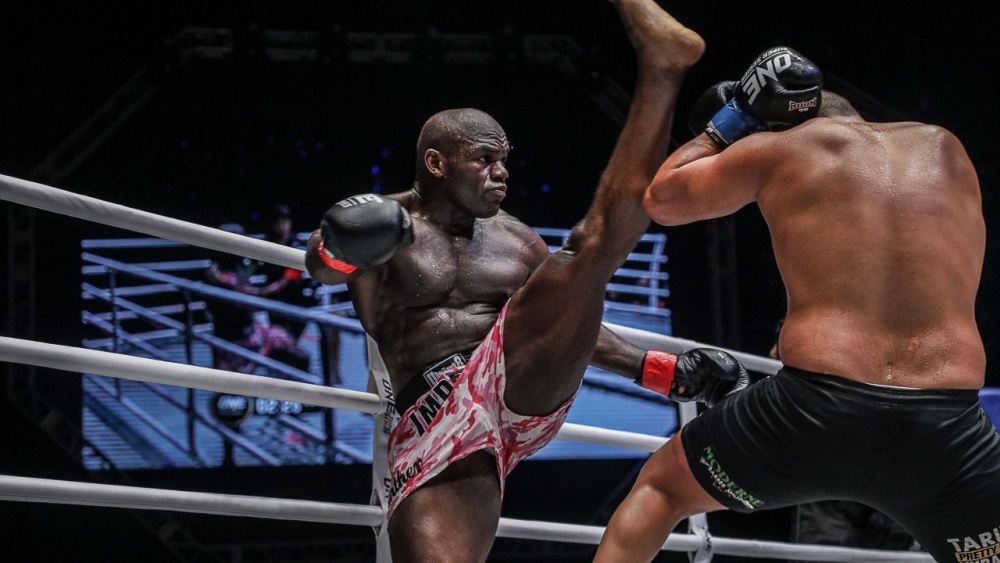
Another advanced technique that you will encounter further down the Muay Thai road is the slapping push kick. Now, this variant of the push kick is also one that is difficult to master, and as such, you will rarely see it used by fighters. The idea is to lift the leg and knee high in the air to stomp or slap the sole of the foot on the opponent from the chest upwards.
This type of push kick is an excellent way to counter an opponent that approaches recklessly, as it can give them a nasty surprise on the way into range. In order to pull off this kick, a fighter must have tremendous balance, technical ability, and excellent flexibility.
If you are interested to master the Muay Thai Push Kick, consider getting the Muay Thai Push Kick Training Series by Evolve University, a 4-hour online course taught by the legendary Muay Thai World Champions of Evolve MMA.
For many combat sports enthusiasts around the world, Muay Thai is synonymous with knee strikes. For many “Farangs” (a word meaning “foreigner” to Thais) who grew up playing the Street Fighter video games, they will most likely remember the “Sagat” character as their first introduction to the Muay Thai fighting style. This fearsome video game boss was also likely based on Muay Thai legend Sagat Petchyindee.
One of the standout features of this character was his flying knee – a strike that was unusual when compared to the kicks and punches in Bruce Lee movies, or any martial arts film for that matter. The knees, however, are an integral part of the “Art of Eight Limbs,” and contribute to the comprehensive fighting system of the most refined striking discipline known to man.
Knee strikes can be your ticket to overcoming the challenge of any opponent, outside or inside of the clinch. From short-range knee strikes to flying knee variants, the sheer power and effectiveness of these strikes have led to many mixed martial artists basing their standup game almost exclusively on Muay Thai. Knees can be big business inside the ring or cage.
The Muay Khao (knee fighter) style is based on the heavy use of knees. Fighters such as the legendary Dieselnoi, Petchboonchu FA Group, and Sagetdao Petpayathai are regarded among the premier knee fighters of all time. However, they all started where you are today – as a beginner.
So, let’s get down to business and look at some of the main knee strikes in Muay Thai.
Straight Knee
As the most direct knee strike in Muay Thai, the straight knee is likely the first that you will learn. Usually targeted at the opponent’s torso, the straight knee can be landed from inside or outside the clinch and directed at the chest area beneath the breastbone. Make no mistake, if you land this strike, it will not go unrecognized by your opponent.
If you can grasp their head down in the clinch, you can use the upward momentum and thrust to make a real impression. This strike is almost spear-like in its delivery, making it a weapon that every ambitious fighter should add to their collection.
A few tips when throwing the rear straight knee strike:
- Step forward while fully extending the front leg.
- To build power from your hips, push them forward to gain momentum.
- Extend the knee diagonally while aiming for the opponent’s upper abdomen – the positioning of the knee makes the strike more effective.
- Lean back in order to generate more force.
- Keep your chin into your chest for protection.
- Your kneeing shin should be slightly vertical when landing.
- When throwing from mid-range, push your front elbow out to protect from counters and help you maintain balance.
Curved Knee
The curved knee is another perfect technique to learn as a beginner. This knee strike is most effective in short range, such as in very close clinches. You can aim this shot at your opponent’s sides, such as their ribs, hips, and thighs. While this type of knee is unlikely to hurt your opponent as much as other knees, it can be very effective at wearing them down and taking a little out of their gas tank.
A few tips when throwing a curved knee:
- Ensure you have a strong position in the clinch.
- Take a step to the side or rotate your opponent’s body slightly at an angle.
- Take a short step back and fire the knee into their side.
- Rotate your hips as you curve your knee into your target.
Diagonal Knee
This is another close to mid-range knee strike that is effective outside or inside the clinch. The mechanics of this knee make it a difficult strike to anticipate and a potential showstopper if landed correctly. When throwing the diagonal knee, you should aim for your opponent’s sides, especially the ribs.
When throwing the diagonal knee from a loose clinch:
- Take a small step backward on your front foot.
- Bring your striking leg forward at the same time.
- Twist your leg slightly so that the part of your leg from the knee down is pointing at an outward 45-degree angle at the point of contact.
Horizontal Knee
Many fighters frequently use the horizontal knee in both offense and defense. Given that the strike is fairly easy to land, with the right technique, this knee can be your saving grace at times. In fact, some fighters will move into a horizontal knee guard as soon as they have made contact with their target, as this can create a barrier between a competitor and their opponent.
The horizontal knee is effective when thrown from the rear and lead legs. When in the clinch, the switch can also catch an opponent off guard, which adds to the variety of this knee strike. However, if not executed properly, you can expose yourself to being swept off your standing leg, so work hard on your balance and how to gain leverage over your opponent in the clinch while drilling this strike.
When throwing the horizontal knee:
- Lift the throwing leg up so it is parallel to the floor.
- Explode forward while twisting your shin into the target.
- Pivot on the standing leg and twist in order to build power.
Long Knee
The long knee is a strike that is most effective when thrown from long range, rather than short or mid-range. The building of momentum allows for a more explosive impact, making it a potential showstopper, too. Even if your opponent sees the strike coming and has their guard in place, this may not be enough to stop you from breaking through their defense and causing them trouble.
A few tips for the long knee:
- Don’t step straight into your opponent, but angle out slightly.
- Elevate from your front foot with a twist, while driving the knee into your target.
- Ensure the knee is speared into the body of your opponent.
- Drilling this knee at a slow pace is actually more difficult than throwing it with speed, so pick up the pace when practicing it.
Small Knee
The small knee is a solid strike that can be used in the clinch. By shooting small, daggering knees into your opponent’s thighs, you can take some of their mobility away. As such, you can slow the opponent down and make their own kicks and knees less impactful. Additionally, the small knee strike can convince an opponent who has the upper hand in the clinch to break off, allowing you to readjust.
Flying Knee
Last, but by no means least, is the flying knee. While this technique is far from what a beginner should be focusing on, it’s a good bet that you are here for this one. While you need to have sufficient technical nous and a developed balance and posture to land this strike, with the right amount of practice and dedication, you can pull it off.
This strike really works when an opponent is not expecting it. Now, disguising a flying knee is one of the most difficult things you are going to be able to do against an opponent in Muay Thai. You may have seen a number of extraordinary flying strike KOs in MMA, but given that these have been mostly landed when an opponent has been shooting for a takedown – something that you will not be able to avail of in Muay Thai – your chances of landing this strike will be limited.
There are many stages to pulling off a convincing and spectacular flying, with the setup a crucial part of the strike. This requires a solid understanding of the Muay Thai fundamentals, which might be a little advanced for you at this time.
However, when landing a flying knee, here are a few tips:
- Ensure you are within range of your target.
- When throwing the knee, ensure you explode upwards, bending your knees slightly before you drive up.
- Rotate your lead hip back and vice versa.
- Point your knee out as you hit the peak of your jump.
- Keep your chin guarded for counters.
As a beginner in Muay Thai, there may be certain aspects of the sport that draw you in while simultaneously making you worry. The prime candidate here is, of course, elbows strikes.
Although elbows are criminally undervalued and overlooked by many martial artists, the good thing about this is that it gives Muay Thai practitioners the upper hand. Elbows are one area of a Muay Thai fighter’s overall game that makes him stand out amongst practitioners of other martial arts.
In this chapter, we break down five of the most useful elbow strikes a Nak Muay (Thai boxer) can take into the ring.
Horizontal Elbow
First up, is the horizontal elbow, which is effectively the first elbow strike a Muay Thai newcomer should get acquainted with.
Although a very useful and commonly utilized weapon inside the ropes, don’t let this confuse you as to how potent and powerful it can be when executed correctly. The more you watch the sport of Muay Thai, the more you will notice how fighters rely on the horizontal elbow as a means to punish their opponents when they spot an opening.
As ever, in Muay Thai, practice and drilling determine how competent a fighter can be when using this technique. To execute a strong horizontal elbow, you should lift your elbow to a 90-degree angle while holding the outer forearm parallel with your opponent. Similar to the hook punch, you want to follow a slashing motion across your target for maximum effect.
Diagonal Elbow
Many Muay Thai instructors will ask you to imagine an “X” shape in front of you when throwing a diagonal elbow. The outer points of the cross from the top right to the bottom left are where you will start and begin your strikes, both upward and downward in a slicing fashion. An alternative to the cross is to imagine following the paths from 2 to 7 or 11 to 5 on a clock.
With the diagonal elbow, you can really catch your opponent cold and potentially sneak in a fight-winning strike, although to do this, you do not want to load up or telegraph the strikes but execute them as quickly and smoothly as possible. The key to landing this strike is in how fast you can land the strike without suffering any damage in the process. When locked in the clinch, which is as close-range as you can get, you can slice an elbow or two to really give your opponent something to think about.
Upward Elbow
The upward elbow is a fierce strike that can really help a fighter get the better of their counterpart. The mechanics of this technique requires the practitioner to generate upward momentum when targeting the opponent’s chin, jaw, or nose. By pushing upwards, the force carried forward (if landed flush) will push or jolt your opponent’s head backward, potentially ending the fight in the process.
While this strike can be difficult not to telegraph as a newbie to the sport, there are certain things you can work on in order to keep your opponent guessing. For example, you can feint a low kick to drop your opponent’s guard. Alternatively, you could throw a hook to push the guard open, or if close enough, pull the guard down and land the strike.
When throwing the upward elbow, remember to bend your knees before exploding upwards with your elbow towards the target.
Downward Elbow
Ok, so we have covered the upward elbow, so now let’s take a look at the downward elbow.
As almost polar opposites, the difference in technique when throwing the downward elbow compared to the upward elbow will come down to the trajectory of the shot. Unsurprisingly, with the downward elbow, you are bringing the power and momentum from 12 to 6 on a clock, rather than 6 to 12. See your elbow like an ax that is chopping down on wood.
Of course, your positioning will be important when executing this strike, but you must ensure that you can cover the distance and are in range to land the downward elbow before you attempt to throw it. When you are within distance, take a quick step forward and drive the elbow down into the top of your opponent’s skull. An alternative way to throw the downward elbow – and one that can be spectacular to watch – is to land it in the same spot while at the peak of a jump.
Spinning Elbow
As usual, the most difficult techniques should be left to last. Advanced techniques should not be attempted until you have established good balance, flexibility, dexterity, and posture in Muay Thai, so the spinning elbow is certainly one that is not suitable for beginners.
When you are confident and are proficient with your Muay Thai fundamentals, you may feel ready to try this technique out in the gym. Using a heavy bag, you can test your form and put it into practice without running the risk of being hit back. However, you should always train any strike as though you could be hit. If not, you will be in for a wake-up call when you try to pull it off against an opponent.
A few tips to help you with your spinning elbow technique:
- Step out with your lead leg crossed with your rear leg.
- When following through with the spin, ensure your body twists in order to generate the swing in your elbow.
- Practice equally as hard on the final stage of this move as you do on the strike itself.
The clinch is one of the most important aspects of Muay Thai. Period.
A strong clinch game can be the difference between winning and losing in Thailand’s national sport, making it a crucial skill to learn.
In basic terms, the clinch is akin to grappling on the feet with the aim of dominating your opponent in order to land significant close-range strikes, score points on the judges’ scorecards, or even to wear them down and cause damage that you can exploit in the fight. There are a number of offensive and defensive benefits a master of the clinch can avail of, but honing your clinch technique to a solid level will take much practice. Well-known clinch fighters include Muay Thai legends such as Dieselnoi, Petchboonchu FA Group, and Sagetdao Petpayathai.
There are a number of things that you will need to develop in order to perfect your clinch game. Below, we will cover how upper body strength, balance, posture technical awareness, and a number of other factors contribute to how efficiently a fighter can clinch up their opponents.
The Basics
The clinch can benefit a fighter that is looking to fight on the inside. A fighter who prefers clinch fighting is not always the stronger and larger of the two, as technically superior fighters can dominate those who are bigger than them. However, for the most part, the stronger fighter – and especially Muay Khaos (knee fighters) – will base their game on the clinch.
Here are a few basics of the clinch:
- The clinch is effective when looking to control your opponent.
- The mechanics of the clinch involve the placement of the arms over the joints of the opponent’s, to keep them suspended and unable to block, parry, and evade.
- By closing the distance between you and your opponent – through various strikes, feints, and a combination of both – you can grab them and enforce dominance over them.
- Controlling the head and neck ensures that you can land elbows and knees while restricting their ability to defend themselves.
- Pulling an opponent’s head down allows a fighter to land devastating knees or elbows that can end a contest.
Variations Of The Clinch
There are a number of variations of the clinch that every fighter must learn in order to be efficient inside the ropes. Below, you will find the three main types of clinches used in Muay Thai:
The Single Collar Tie
In order to execute the single collar tie, a fighter must grasp their opponent’s head or neck with one arm while pulling their shoulder down with the lead arm. The lead elbow should lock into the opponent’s bicep and forearm to immobilize their movement.
The Double Collar Tie
Using both hands, a fighter will clasp the back of the opponent’s head while keeping it in position with the use of the elbows. So, place an elbow on each side of the head and the shoulders and enforce a tight grip that gives you the leverage to control their head. Doing so will create a strong grip that keeps them in place and at the mercy of your strikes.
The Double Underhook
Many smaller and lighter opponents gravitate to this technique as it helps them to deal with taller opponents. A fighter aiming to lock in a double underhook should look to get in as close to their opponent as possible before hooking their arms around the upper part of their body. By bending the lead foot and pushing the rear leg back, this can then open up sufficient distance to land a knee or even sweep the opponent.
Of course, there are many attacks that can be landed from inside the clinch, so let’s move on to those.
The Clinch: Basic Attacks
Naturally, you will have limited attacking opportunities in the clinch as you will be up close and personal with your opponent (so ensure you have breath mints). Of course, you could attack them with bad breath, but that wouldn’t be very sporting. Alternatively, you can work on your shortest of short-range strikes which means that elbows, knees, and punches will be your most promising methods when landing strikes.
Of course, an attacking platform from the clinch is determined by your control of your opponent. Working your way into a position of dominance is crucial for creating openings. If you haven’t already factored your gas tank into the equation, now is a time to think about it. Clinching can really drain a fighter, so remember to be efficient with your energy.
The Clinch: Basic Defense
Aside from being tied up, having your neck and shoulders cranked, and running the risk of being swept off your feet (and not in a romantic way), you will need to protect yourself from eating shots while in the clinch. As knees are the most common strikes from inside the clinch, keeping your hips as close to your opponent as possible will help prevent them from gaining dominance.
Your posture will also be very important, so, ensure that you stand as upright as possible in order to keep your head from being grabbed. Don’t put your chin too high in the air, however, as you could provide your opponent with the perfect opportunity to land an elbow on your chin. The key to basic clinch defense is a lot of practice with a training partner and plenty of exposure to being in a position where you are uncomfortable.
If you are interested to master the Muay Thai Clinch, consider getting the Muay Thai Clinch Master Course by Evolve University, a 8-hour online course taught by the legendary Muay Thai World Champions of Evolve MMA.
Anyone with ambitions of becoming a proficient competitor in Muay Thai needs to seriously work on their defense. Before anything else, a strong defense provides a practitioner with the license to operate inside the ropes.
After all, if you cannot protect yourself, how long do you think you will last? You could have the slickest jab and the most badass roundhouse in your gym, but if you can’t avoid punishment, you’ve already failed. In this sport, any opponent worth their salt will be testing your guard, footwork, mobility, clinch, as well as your effectiveness in blocking punches, kicks, elbows, knees.
You could have an exceptional chin, but if you can’t get out of the way of low kicks, you’ll be in serious trouble. And why would you want to compromise that pretty face of yours, or take more punishment than you have to? Simply put, your defense is the wall preventing your opponent from entering your domain. Be the king or queen of the castle, and ensure they are kept out as much as possible.
Here’s how.
The Guard
Whether in sparring or competition, sooner or later, you will be hit. How hard and how frequently you are hit is entirely up to you. While you may believe you have the silky, evasive skills of Muay Femurs (technicians) such as Samart Payakaroon and Saenchai, a few shots to the face and solar plexus can wake you up from that illusion. Fast.
Even the greatest and most defensively sound fighters in the history of Muay Thai have relied on their guards. There will be times when you have no option but to block shots by using your guard. For example, an opponent might trap you against the ropes or in a corner, preventing you from making a sharp exit or evading their punches with head movement or smart maneuvers. There is no shame in this at all.
Yes, it is important to be able to take punches, kicks, knees, and elbows in Muay Thai if you are serious about competing in the sport, but allowing yourself to eat shots should be your last resort.
Observation And Anticipation
A very important aspect of a fighter’s defensive prowess is their ability to pay attention to their opponent’s movements and gestures. While smart fighters disguise many of their shots and movements with feints, switches, and physical “lies,” it pays to observe how they throw their shots. Even the best fighters are guilty of giving away clues that can be exploited later in an attacking sense, but you also use this information to your advantage in a defensive capacity.
For example, your opponent may overuse the same jab feint – drop shoulder – pull back – leg kick combination. This means that, when they are approaching and have feinted the jab and dropped the shoulder, you can strike with a roundhouse or even move in for the clinch, before they complete the pattern. Some fighters tend to telegraph certain shots or show their cards in other ways, which also gives you an opportunity to prepare for what is coming.
By observing your opponent’s movements – and anticipating the strike or pattern of their combinations – you can buy yourself time to move out of range or prepare to counter. All of this information should be stored and be ready to exploited when the time comes.
Elusiveness And Head Movement
Standing in the same spot like a statue is basically imploring your opponent to get stuck into you. A lack of movement is the greatest gift a practitioner can give to their opponent, as it provides them with an easy platform of attack. In order to keep your opponent guessing, and to prevent them from cutting the ring off and trapping you like a wild animal, you need to move. A lot.
Once again, the most proficient Muay Thai technicians are usually those who gravitate towards an elusive style of defensive fighting. The spectacular, crowd-pleasing slips, bobs, weaves, and glides out of range might be amazing to watch, but elusive fighting isn’t all entertainment. Nor does it have to be difficult.
Rather than standing in the same position, shelling up in your guard and learning how to slip and parry shots, you add another string to your defensive bow. In time, a dedicated fighter will learn how to use head movement and footwork to move outside of the way of their opponent’s attacks. When you can measure distance and range, you will stand a greater chance of avoiding what an opponent has to throw at you.
Teeps, Counters, And Checks
A strong teep game is essential to a Muay Thai practitioner’s approach in a fight. While there are numerous attacking benefits to the teep, there is no doubting just how effective it can be in keeping your opponent from getting inside and doing damage. By using the teep – also known as the push kick – a fighter can disrupt the rhythm of their opponent and even buy themselves space by pushing them back across the ring.
Teeps work well as counter shots, too. Speaking of counter shots, these are also very important defensive tools, as they can prevent an opponent from finding their groove as well as helping a fighter transition from a position of defensive vulnerability to attacking advantage in the blink of an eye.
When it comes to stopping leg kicks from doing damage, fighters should also work on their checking game, as this can prevent an opponent from targeting the legs frequently. By lifting the leg up, you can also block an opponent’s shots to the midsection, including their teeps.
Conditioning, Balance, And Footwork
At the absolute bedrock of your defense is your conditioning. It is of vital importance to ensure that you are fit and in fighting shape if you want to have any chance of winning a fight. You could be the most elusive and defensive-minded fighter in the world, but if you can’t catch your breath, you are a sitting duck.
In addition to being in fighting shape, you need to work very hard on your balance and footwork to ensure that you have the ability to move in and out of range, and escape your opponent’s attacks. As such, constant drills and sparring sessions will become the currency that buys you a rightful ticket inside the ropes come fight night.
Chapter 9: The Different Styles Of Muay Thai
Considering the sport is regarded as the “Art of Eight Limbs,” it is perhaps no surprise to learn that a Muay Thai fighter has more weapons to take into a competitive situation than practitioners of most other combat sports.
Of course, how a fighter uses these weapons can differ greatly from their opponent’s approach in combat. Some combatants base their general strategy in fights on what they do best, with their physical and technical advantages underpinning their approach in attack and defense. In other words, they have a style that is developed on their size, strength, power, speed, elusiveness, and technical superiority.
In Muay Thai, fighters will generally be coached and develop their game in one of several traditional styles. From tall and strong knee fighters to smaller and speedier technicians, a fighter’s physical attributes can often determine the best way to develop a tactical approach and overall strategy that helps them win fights most efficiently. Additionally, a particular style can often be a fighter’s identity when they enter the ring.
In this chapter, we will take a look at the four fundamental Muay Thai styles and how they work, starting with the Muay Khao.
Muay Khao
The Muay Khao (knee fighter) is a fighter that places a strong emphasis on powerful knee strikes. This type of fighter is typically strong and tall, with a forceful and relentless approach to combat. Expect this fighter to look for the clinch at every opportunity, trapping their opponent’s like spiders with a web in order to use their favourite weapon (the knee) to maximum effect.
As most powerful knee strikes tend to be delivered from close range, the Muay Khao works very hard to hone their clinching game, as well as their knee strikes. Their technique is based on overwhelming other fighters with superior arm positioning and strength in the clinch, and frequent use of elbows, throws, as well as knees. With an attritional and explosive style of fighting, the Muay Khao stalks opponents, aiming to capitalize on cutting the ring off and trapping them against the ropes.
There have been some exceptional Muay Khaos in the sport over the years. If you believe that this is the style for you, study the likes of Dieselnoi Chor Tanasukarn, Petchboonchu FA Group, and Sagetdao Petpayathai.
Muay Tae
The Muay Tae (kicking specialist) style is favored by many spectators in Thailand and beyond. Fighters who adopt this style are usually stocky and powerful, with a great engine. They use their kicks like baseball bats and battering rams, targeting the legs, midsection, sides, and arms of their opponents to break them down systematically. The Muay Tae works very hard on their strength and conditioning, as well as their balance, power, and overall kicking technique.
Aside from power, a Muay Tae specialist usually has a great understanding of distance and range. In order to utilize their kicks to maximum effect, they must know when and where to strike and at the right time, all without leaving themselves vulnerable to having their kicks countered, grabbed, or their balancing foot swept. Muay Tae fighters make heavy use of the roundhouse, as this is the most powerful kick in their skillset.
You can expect a Muay Tae stylist to also make frequent use of the teep (also known as the push kick) as a tool to measure distance and to maneuver their opponents into a position where they can land significant strikes.
Muay Thai enthusiasts regard some of the greatest Muay Tae specialists as Buakaw Banchamek, Yodsanklai Fairtex, Pud Pad Noy Worawoot, Kaensak Sor Ploenchit, and Apidej Sit-Hurin.
Muay Mat
The Muay Mat (aggressive puncher and low kicker) is one of the most beloved styles in the sport. With a relentless style that involves constant pressure and taking the fight to the opponent, the Muay Mat typifies the brave and fearless warrior spirit that runs through the blood of many fighters’ veins. One thing is for sure, these practitioners do not back down for anyone.
The Muay Mat will almost always make their intentions known from the first bell, charging forward in order to get up close and personal with their opponents as soon as possible. With solid boxing skills and a very developed low kick, the Muay Mat aims to break their opponents down with close-range shots to the legs and body, before unloading crosses, hooks, and uppercuts to their faces.
This type of fighter often comes with an ultra-aggressive style that is very fan-friendly. They are often revered as the toughest and most passionate fighters, given that they can take as much punishment as they dish out. Fighters like Anuwat Kaewsamrit, Sagat Petchyindee, Rodtang Jitmuangnon, Coban Lookchaomaesaitong, and Ramon Dekkers are among the greatest exponents of the Muay Mat style.
Muay Femur
The Muay Femur style (technician) is beloved by those who appreciate the finer, artistic side of the “Art of the Eight Limbs.” Known as the “King’s Discipline,” the Muay Femur style is based on a slick and seductive technical superiority that allows fighters to use their opponent’s strengths against them. The Muay Femur is usually highly skilled and more advanced than many of their peers.
To break through a door, imagine the approach of a Muay Tae as a battering ram, and a Muay Mat as an explosive device. A Muay Femur, on the other hand, would swiftly and tactfully remove the screws and bolts that hold the door together. To put it another way, their vision, observation, and free-flowing, technical style is built around deconstructing an opponent with style and poise rather than brute force. What they might lack in strength and explosiveness, they make up for in skill.
Given the various attributes that are required to fight in this style, a Muay Femur is often the most technically gifted of all the Muay Thai styles. Some of the greatest fighters in the history of Muay Thai were regarded as technicians, with Samart Payakaroon, Saenchai, Nong-O Gaiyanghadao, and Sam-A Gaiyanghadao standing out in particular.
Developing Your Personal Style
In Muay Thai, styles make fights. As such, there are a number of different ways that a bout can go when it is contested between two fighters who bring varying styles and skillsets into the ring.
As a beginner, focusing on your Muay Thai fundamentals will be required before you begin to develop your own style. However, once you have identified what particular style works for you, personally, you can try to emulate some of the greats on this list.
Much like any other combat sport in the world, Muay Thai has rules and regulations that are needed to maintain order in a fight. For the protection of combatants and to clearly and fairly dictate the outcome of a bout, these laws, codes, and scoring systems help to ensure that everyone involved starts off evenly and with no advantages or disadvantages.
As is the same with other sports, cheating and corruption can, unfortunately, creep their way in. However, focusing on this right now is not going to be congruent to learning about the basics. Therefore, we will look at the rules of Muay Thai and how the scoring system operates in Thailand’s national sport.
The Ins And Outs Of The Scoring System
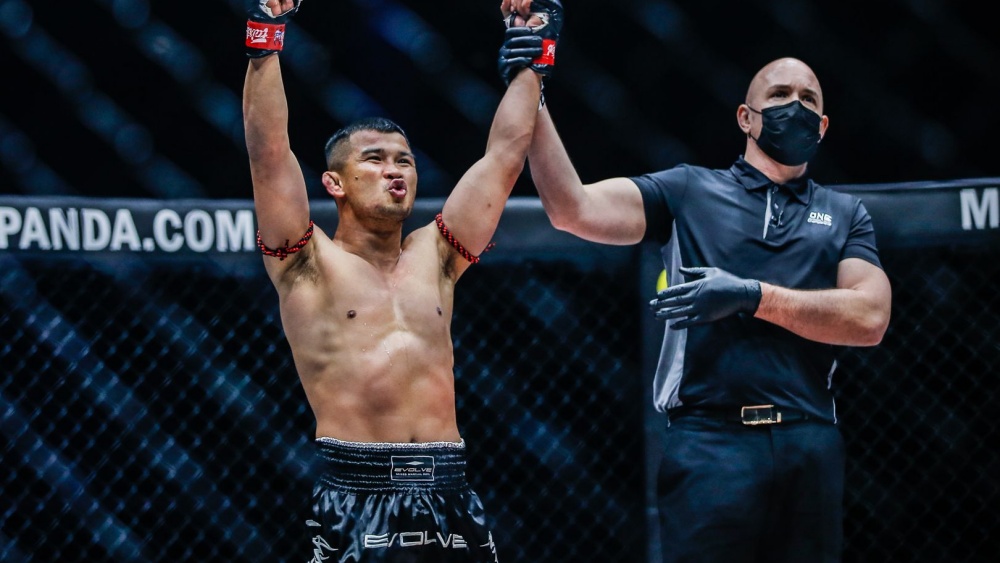
When watching a Muay Thai fight for the first time, it might be difficult to understand the criteria for scoring a bout in favor of one fighter. Although it might be tempting to follow the 10-Point Must System used in Western boxing, things differ in Muay Thai. Whereas boxing is fought between two fighters throughout 10 scheduled rounds, or 12 when a championship is on the line, in Muay Thai, there are five.
In boxing, the supreme fighter in a round is awarded 10 points, with the loser awarded 9. If there is a knockdown, one point will be taken, or two if there are two knockdowns in that round. When the fight is over, the competitor that has scored highest across three judges’ scorecards wins. As such, the bout is scored round by round. This is pretty straightforward.
Muay Thai does not follow this format entirely. The fight is judged as a whole, rather than in 10 or 12 sequences. While points are awarded at the end of rounds, these are usually to assist those scoring the fight in keeping tabs on what happened in each round. Now, this may sound confusing (and even some experienced Muay Thai enthusiasts complain about the system), but by the end of this article, it should make more sense.
The most important thing to keep in mind is that, where a couple of knockdowns in boxing can cost the stronger fighter in the contest a chance at winning, in Muay Thai, the better performer will not suffer the same fate. At least in theory.
The Basic Rules
- A fight consists of 5×3 min rounds with a period of 2 minutes for rest between rounds.
- Rounds are scored up to 10 points per round up to 50 per fight, although the scoring system is based on the entire fight rather than over the course of each round.
- Points are awarded to fighters who land clean strikes and sweeps, demonstrate dominance in the clinch (including a higher rate of knee strikes).
- Dropping an opponent and sweeping an opponent score points.
- If both fighters score simultaneous sweeps, the fighter who lands on top will benefit on the judges’ scorecards.
- Clean shots should be immediately countered or the points will go to the fighter who has landed the initial strike without taking a counter.
- Gloves must be no lighter than 6 ounces and must not be manipulated out of shape.
- No footwear is permitted, other than ankle caps.
What Judges Look For When Scoring a Fight
Judges will look for particular qualities when scoring a Muay Thai fight. There are three basic principles that they will use in order to determine a winner:
- Effective Aggression: This is perhaps the most important aspect of a judges’ scoring criteria. By definition, effective aggression refers to clean, accurate, and powerful strikes with the fists, legs, knees, and elbows. Whether you are moving forward, backward, or to the side, effective aggression is not determined by your direction.
- Ring Generalship: This is a term that is used to identify the fighter that sets the tempo of the fight, looks more comfortable, and essentially takes the contest to the opponent.
- Pure Aggression: And finally, pure aggression is also something that a judge will want to see in order to score a fight in favor of one corner. Pure aggression is defined as pursuing and forcing a fight on a competitor that frequently retreats and avoids contact.
Knowing What Strikes Score the Most
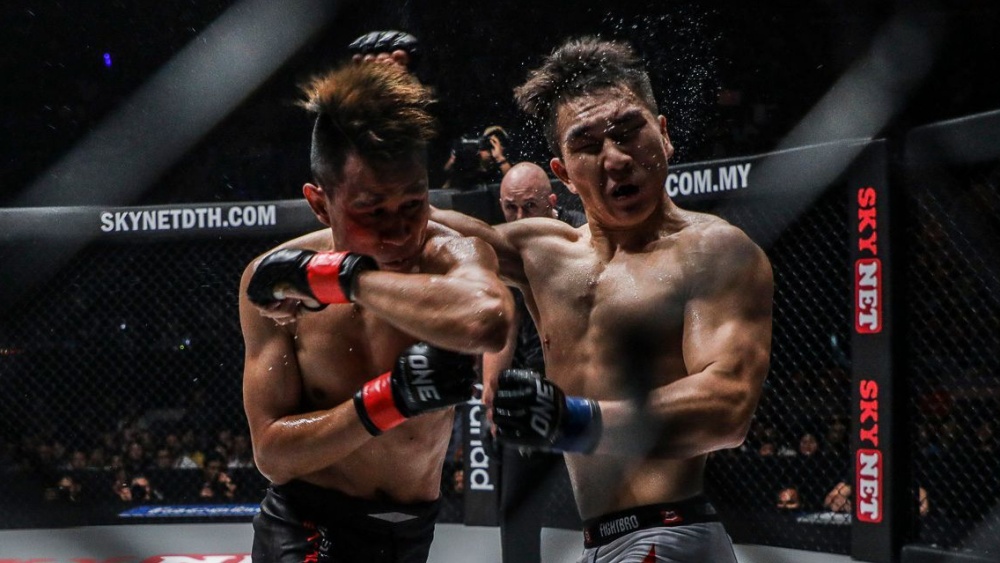
As you might guess, a judge will score the cleanest, most technical, and most damaging strikes higher. The shots that have a bigger impact on your opponent – whether they knock them down, make them wince, or visibly affect their ability to fight – will count considerably when scoring a fight. Combinations and spectacular strikes will also get the attention of the judges.
- Being effective is crucial when attacking – if shots are weak and do no damage, they will be ignored.
- If both fighters are throwing a lot of shots but doing little to no damage, the fighter who displays the better skillset and more creativity will score higher.
- Conversely, defensive ingenuity, counterattacks, and avoiding shots while causing damage to your opponent will also earn you favorable scores with the judges.
The First And Fifth Rounds
The first and fifth rounds fall into the category of the “unspoken rules” in a Muay Thai contest and form a part of the unique way that a fight is scored.
The first round of a Muay Thai fight is typically a “feeling out” round where fighters will use the time to figure out their opponent. It is not uncommon for fighters to hold their cards close to their chest in this round as they try to create mental maps involving their opponent’s movements, styles, and weaknesses that can be exploited later in the fight.
As the real action tends to occur from the second to fourth rounds, when fighters work to impose their will on their opponent, the fifth round can often see fighters bring the pace down if they are confident that they have done enough to win. Some fighters will begin celebrating before the end of the round, raising their hands in the air and even receiving a touch on their gloves from their opponent as a mark of respect and acknowledgment of their superiority in the fight.
While the Muay Thai scoring system comes in for criticism at times, as a competitor, it pays to familiarize yourself with how judges operate. Doing so will certainly give you a greater appreciation for what really matters in a fight, helping you to work on these key points in training.
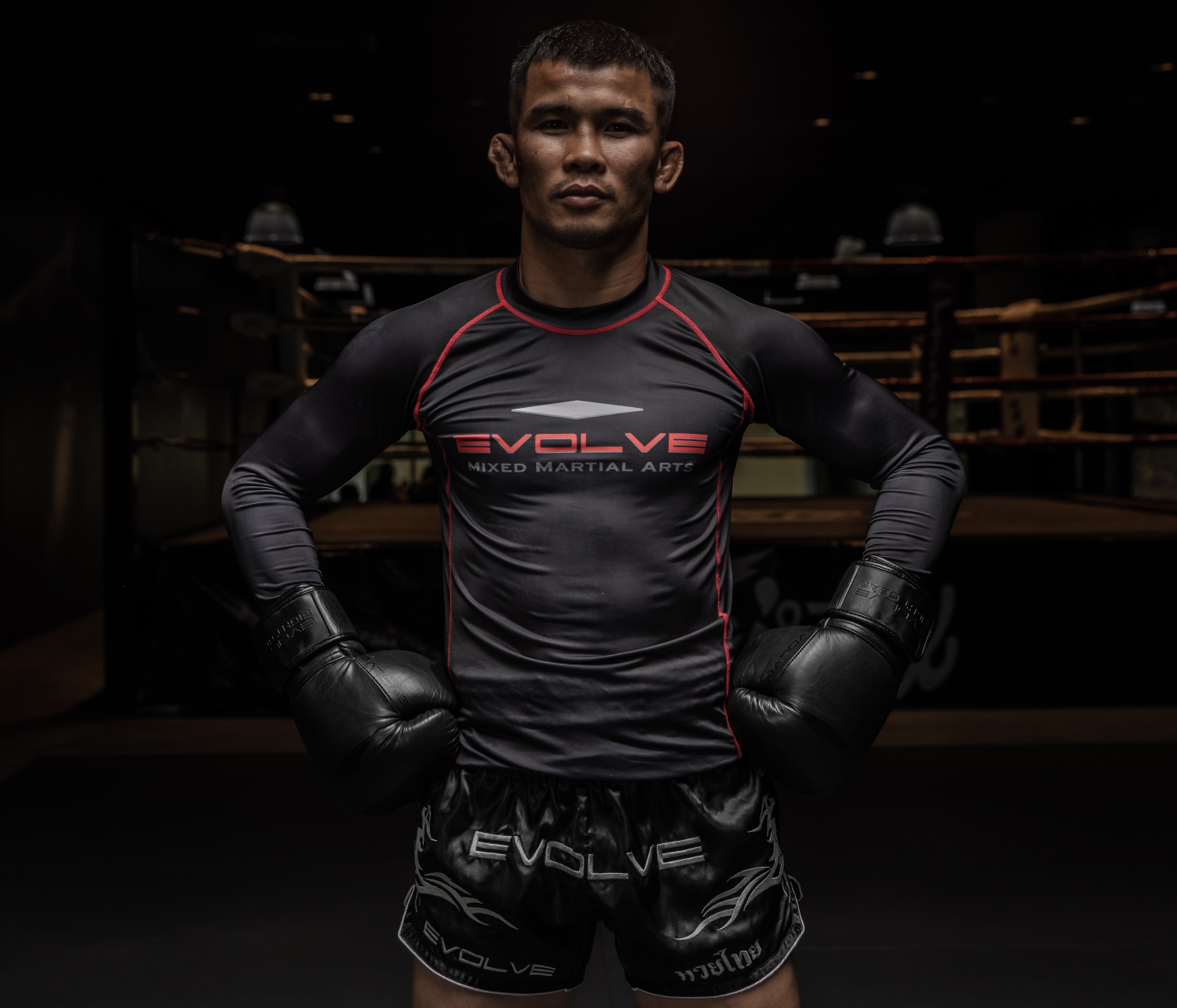
The first thing you’ll need to do is to get the right gear to take part, but luckily, that’s the easy part, and it won’t break the bank. At first, all you’ll need is some comfortable, loose-fitting clothes that will allow you to move freely and do what your Muay Thai instructors ask. Shorts and a T-shirt are fine, or you can put on a tank top, spats, or anything else you feel good in.
If you want to look the part and wear the ideal apparel, invest in some real Muay Thai shorts. These are usually made from nylon or satin, and are cut off about halfway up the thighs to reduce any friction to ensure you can kick with ease. Plus, there are infinite combinations of colors and styles available, so you can choose a design that suits your style and personality.
Gear Up
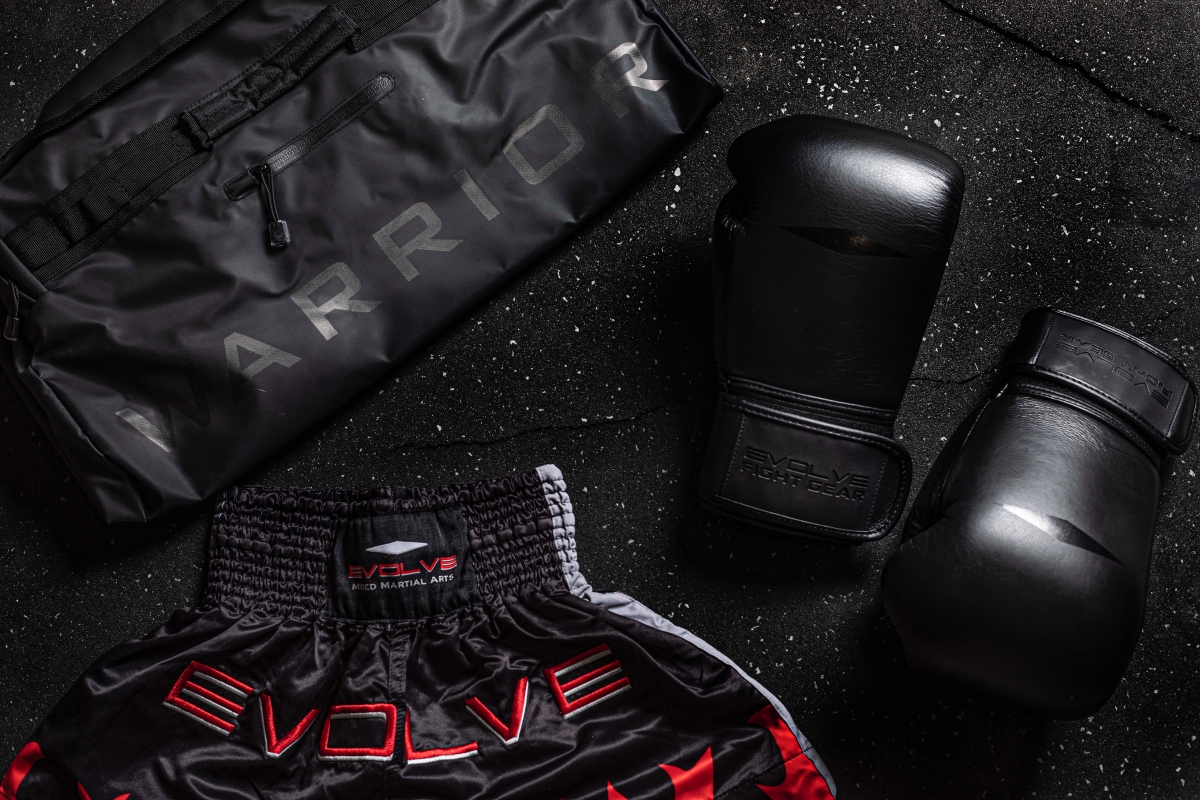
As a beginner, when it comes to equipment, you can get away with turning up empty-handed, but we would not recommend that beyond your very first session or two. Though you might be able to borrow some boxing gloves, you will not want to make a habit of it.
It does not cost much to pick up a pair of new gloves, or you could set yourself up for the long-haul with a pair that is built to last from the Evolve Fight Gear store. There are plenty of other sizes available, but for first-timers who are not yet ready to start sparring, 10oz or 14oz is ideal. A good pair of leather gloves could help to protect your hands from the impact of bags and pads for years.
You’ll also want to get some hand wraps, which martial artists use to protect their hands and wrists. If you’re new to combat sports, ‘traditional’ wraps might seem a bit confusing, but you’ll be binding your wrists and knuckles in no time with a bit of practice and our expert guidance.
Of course, that’s not all you’ll need as you progress in your Muay Thai education. Shin guards, mouth guards, and groin guards are all essential once you graduate to more advanced drills and sparring, but you won’t need to worry about investing in these until you’ve come to grips with things.
Chapter 12: Etiquette And Tips For Your First Class
Muay Thai gyms can be intimidating for newcomers, but you will find they are welcoming places if you conduct yourself the right way.
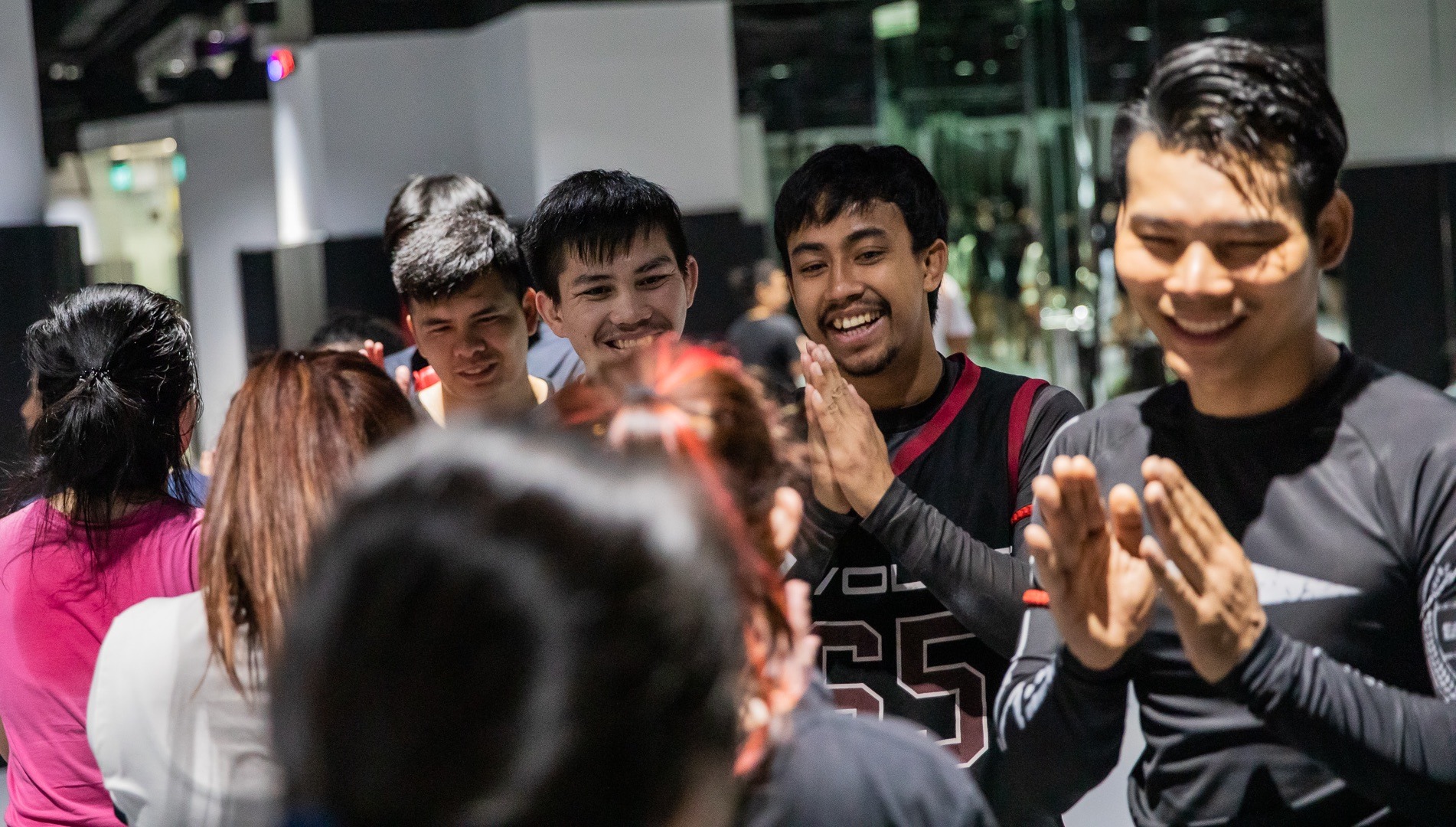
The way you conduct yourself comes down to one thing – respect. All martial arts are built on this value that has run through them for thousands of years. Despite the long history, this is a simple concept. As long as you recognize the rules and appreciate everyone in your class, you can’t go wrong.
In this chapter, we’ve come up with some tips on what to look out for while training at the Muay Thai gym. Sticking to these guidelines will show the appropriate respect to your coaches and training partners, and will help you fit right in wherever you train.
Turn Up On Time
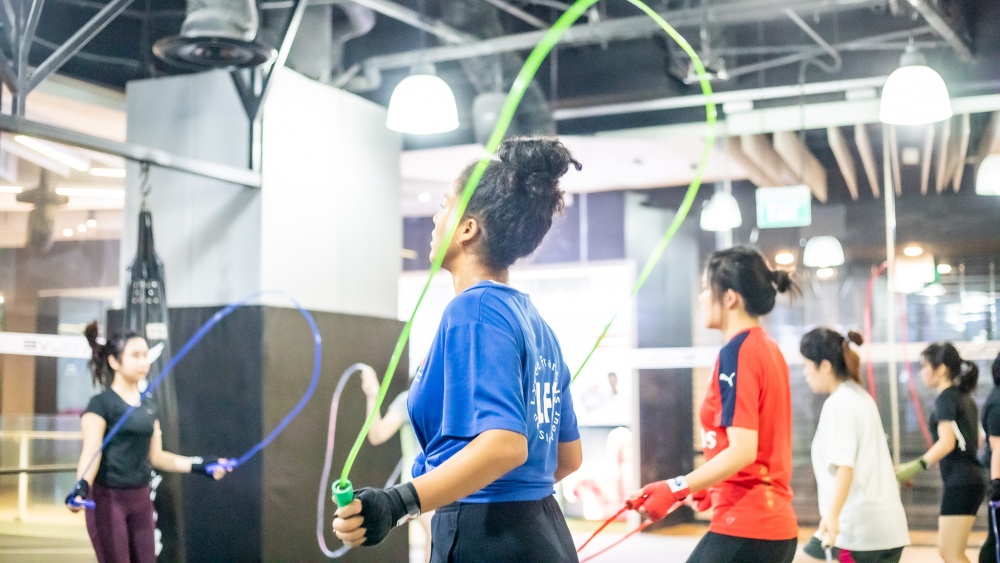
Make sure you arrive at the gym in time for the start of the class, ready to train.
It would be considered rude or disrespectful for you to turn up late to a job or social engagement, so why should martial arts practice be any different?
Whether you’re training to fight or you’re just a Muay Thai hobbyist, you owe it to your coach, your teammates, and yourself to be punctual.
If you run onto the mats five minutes after the start of class, you’ll disrupt the lesson and will waste everyone’s time while they wait for you to catch up on what you’ve missed.
You’re also likely to miss valuable warm-up time, which could lead to injury.
Some instructors may not even let you join a class if you miss the start. Others might allow you to join in, but not before you pay the price for your lack of punctuality. Want to avoid 50+ burpees? Arrive when you’re supposed to.
The best practice is to turn up a little early, giving you an ample amount of time to stretch, wrap your hands, and even catch up with friends before it’s time to get serious.
Listen To Your Coach
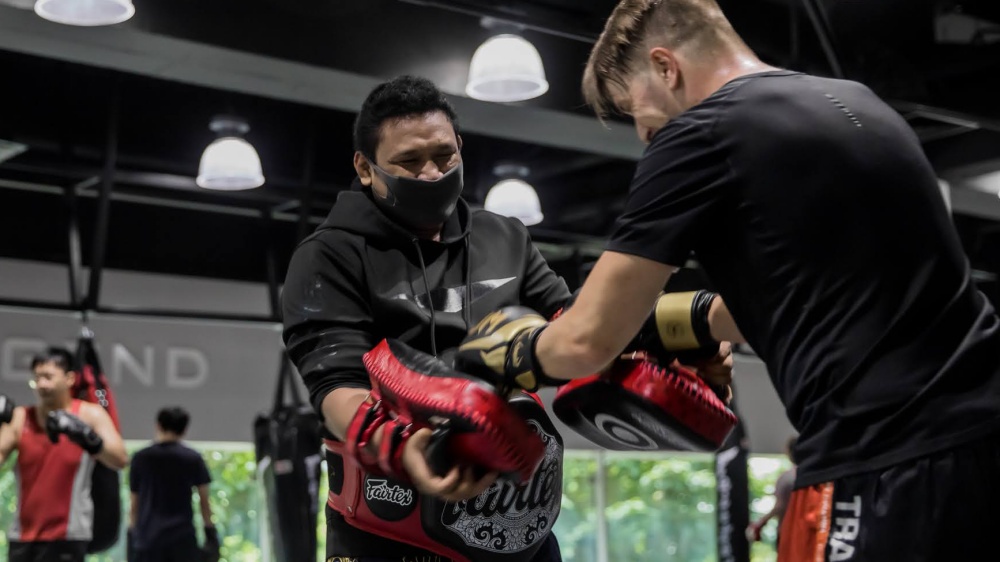
It’s just plain rude to not pay attention to your coach. They are the fountain of all your martial arts knowledge, and they demand your respect.
Most trainers don’t mind having to explain a technique or concept several times – especially if it’s difficult, complex, or unfamiliar – but not if it’s because you didn’t listen to them the first time.
You can chat about what you saw on TV last night after class, not while your instructor tells you what to do or how to do it.
If you’re not focused on what you’re being shown, not only will you make your coach angry, you’ll end up doing something wrong. That could mean you pick up some bad habits that could stay with you for a long time.
You’re forking over your hard-earned cash to learn from your coach, so try to absorb whatever knowledge they share with you.
Treat Your Training Partners How You’d Want To Be Treated
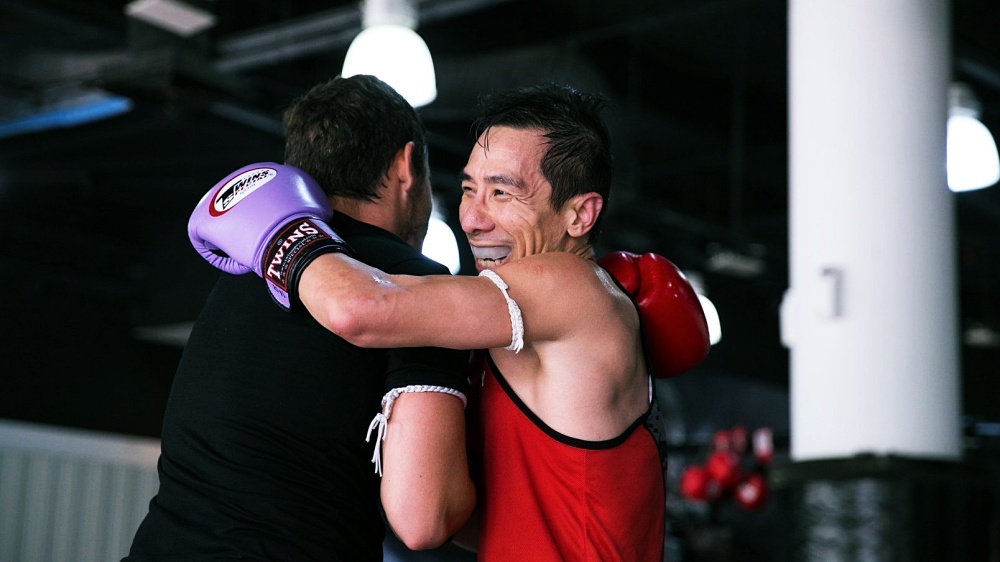
Muay Thai gyms should create a welcoming environment where anyone can come and learn the Art of Eight Limbs, so help to keep it that way.
In mixed-ability sessions, you might be partnered with someone with less experience, so don’t get frustrated with them if they can’t hold pads for 12-strike combinations.
Everyone was a beginner once, so remember what it was like when you started. Try to guide them through the process. Once they get the hang of things, they’ll become a valuable training partner.
If you’re a newbie and pair up with someone who’s far more experienced, try to relax and listen to their advice.
Overall, just be friendly to everyone. It’s not okay to be antisocial or behave inappropriately anywhere. If you do so in the gym and dissuade anyone from coming back, you might be asked to leave, too.
Keep It Clean
If you don’t look after your personal hygiene, no one will want to train with you.
Make sure you air out or wash your equipment after every session so it’s clean and bacteria-free when you step back onto the mats.
Keep a towel handy in the gym so you can wipe excess sweat away before you cover all your friends. If you have long hair, keep it tied back and out of the way.
Also, wash your hands before you practice clinching. Smell your hands when you take your gloves off to find out why!
You should also keep your fingernails and toenails trimmed. They can also scratch, or worse. There are also horror stories about serious injuries being caused by untrimmed talons.
Finally, if you have any cuts, make sure they’re covered up before you step on the mats, and dress them immediately if they get exposed.
Tips For Your First Class
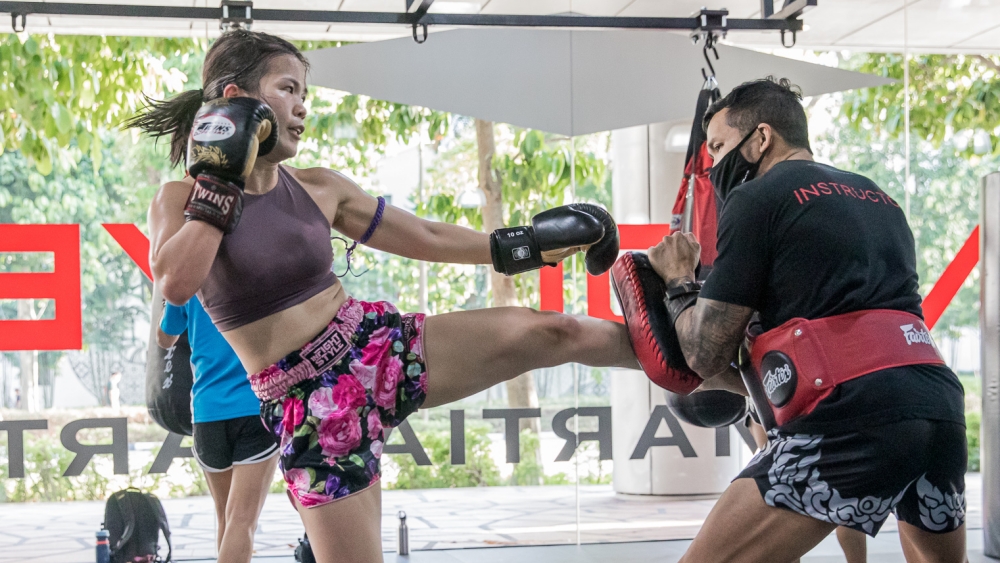
If you’ve set foot in a Muay Thai gym as a newcomer and feel intimidated when you step into a new gym for the first time, you’re not alone. However, there’s no need to worry. You’ll be welcomed as a new member of the martial arts family as soon as you step onto the mat.
While you get your feet wet in your new martial arts family, keep these things in mind to help yourself adjust and adapt.
- Get to know the gym and instructors:
On your first day, turn up a little early to get to know the layout of the gym – where to sign in, where to get changed, and where everything is kept. Also, don’t be afraid to introduce yourself to your instructors – they won’t bite! If you’re nervous, you can explain that it’s your first time, and you can be sure these experienced experts will help you ease into things. - Don’t be scared to ask questions:
Don’t understand something? Worried you’re not doing something right? Don’t sweat it. Just ask one of the coaches or even one of the other people in the class to help you out. The atmosphere is always supportive and everyone around you knows what it feels like to start out. Everyone was a beginner once. - Give it your all:
Whether you’ve taken up Muay Thai to get fit, train toward competing, or just to try something new, make the most of your time on the mats. If you can’t do something right at first, don’t give up! Practice makes perfect, and a good attitude will go a long way with your instructors. - Relax and have fun:
While you should try your best in Muay Thai class, no one expects you to be as well-conditioned as Nong-O Gaiyanghadao, as fast as Sam-A Gaiyanghadao, or as technical as Penaek Sitnumnoi. While you should try your best, make sure you go at your own pace, too. It’s best to take your time and stay loose. That will help with your technique and help you to learn. All that should contribute to a great time.
Once you’ve found your feet, you’ll probably wonder how often you should train. The truth is, there’s no right answer.
If you’re just training for general health and fitness, a few Muay Thai classes a week will be enough. You might be surprised about how quickly you’ll see improvements in your strength, cardio, and flexibility after taking part in classes for a month or two.
Of course, the more you train, the more benefits you’ll feel, and if you’ve got your eyes on competition, you’ll want to train as often as you can. If you come to beginners’ Muay Thai classes five times a week, for example, you’ll be well on your way to punching your ticket to more advanced classes, new techniques, sparring sessions, and more. When you’re ready, your instructors will be delighted to promote you.
However, if you’re that keen to throw yourself into Muay Thai, it’s important to know your limits and listen to your body. If you’re tired, it’s probably time to rest for a day or two.
Supplement Your Training

If you’re feeling good and itching to make progress even when you’re outside the Muay Thai gym, there are plenty of things you can do to give you an extra edge when it’s time for Muay Thai.
- Running:
Anyone can grab their sneakers and go for a run to supercharge their training. How far and how often you go for a jog depends on your fitness level or goals, but a few kilometers a few times a week will give your cardio a big shot in the arm. You could also try sprints for a shorter, high-intensity workout. - Skipping:
You’ll be jumping rope in class a lot, so it wouldn’t hurt to practice on your own time. A rope costs next to nothing, and you only need a small space to do it. A few extra rounds will help your conditioning, and once you learn a few tricks, your footwork is bound to improve, too. - Strength and conditioning:
Muay Thai is a demanding endeavor that rewards those who make the effort to boost their power, fitness, and endurance. Any extra workouts will help you, but it’s best to focus on exercises that work the whole body because there’s not a single muscle that won’t get used in the Art of Eight Limbs. Evolve MMA’s own WarriorFit classes are perfect for fine-tuning your body. - Stretching:
Increased flexibility and mobility will help you kick higher, achieve better balance, and control your body. Every class will begin with a routine to warm you up, but if you stretch daily on your own time, you might be surprised about how far your body will go. Half an hour when you wake up could work wonders, as would yoga classes. - Watch fights:
There is no better way to see how Muay Thai techniques are best used than by watching them being put into practice. There are countless videos on YouTube showing everything from legends from the past to today’s up-and-comers. To see some of Evolve’s coaches in action, look back at their bouts in ONE Championship or watch live on the organization’s app on fight night.
Chapter 14: Choosing A Muay Thai Gym
As the “Art of Eight Limbs” grows in popularity the world over, Muay Thai gyms are popping up everywhere.
Budding nak muays are spoiled for choice when it comes to picking somewhere to train. If you don’t know what to look for, it might be difficult to decide what’s right for you.
Without expert knowledge, you could end up failing to keep up with a group of experts, or struggling to learn ineffective techniques from a con artist at a McDojo.
With our advice you should get everything you need to know about choosing the right place to learn Muay Thai – one that’s welcoming, teaches you the skills and values of martial arts, and will help you reach your goals.
Accessibility
Before we even get started with what makes a good gym, ask yourself whether you can fit the gym’s timetable of classes around the rest of your professional and social life. If you’re new to the sport and beginner’s classes clash with your shifts at work, it may not be the place for you.
Likewise, if you have to take three buses or drive more than an hour to get to and fro training, are you prepared to make that trip multiple times a week?
If you’re a dedicated Nak Muay, you can work around these issues, but others may want to go somewhere that’s a bit more convenient.
Even if you are willing to rearrange your schedule or buy that travel pass, make sure you check out the rest of these factors to make sure it’s worth it.
Reputation
Now more than ever, it’s easy to get a good idea about what a gym is like before you even set foot on the mats.
If you see a busy room with a lot of smiling faces, the chances are that you’re onto a winner.
Not convinced? Just ask. A lot of gyms thrive on word of mouth, so talk to people and find out what they think of your prospective training center.
You can also go online to social media or martial arts forums to do some research and discover if your targeted training center is for you.
If its members are known as ‘The Murder Squad’ and have a reputation for taking no prisoners in sparring, you might want to look somewhere else for your introduction to Muay Thai.
Coaches
It’s important to avoid a charlatan and find an accomplished coach you like and respect.
It’s always worth doing your research to find out if the head instructor is infamous for boasting about fake or dubious credentials. These guys are to be avoided.
Finding a trainer with a record of professional fights and title wins is often a good sign, but you’ll never really know how good they are as a teacher until you experience their methods first-hand.
Your ideal coach is passionate about the sport and their students. They’ll also be patient, attentive, and try to divide their time equally among the people they teach.
If you can find someone who welcomes you to the gym for your first session, and then takes you through some of the basics before you start the class, you could be on to a winner.
Training Partners
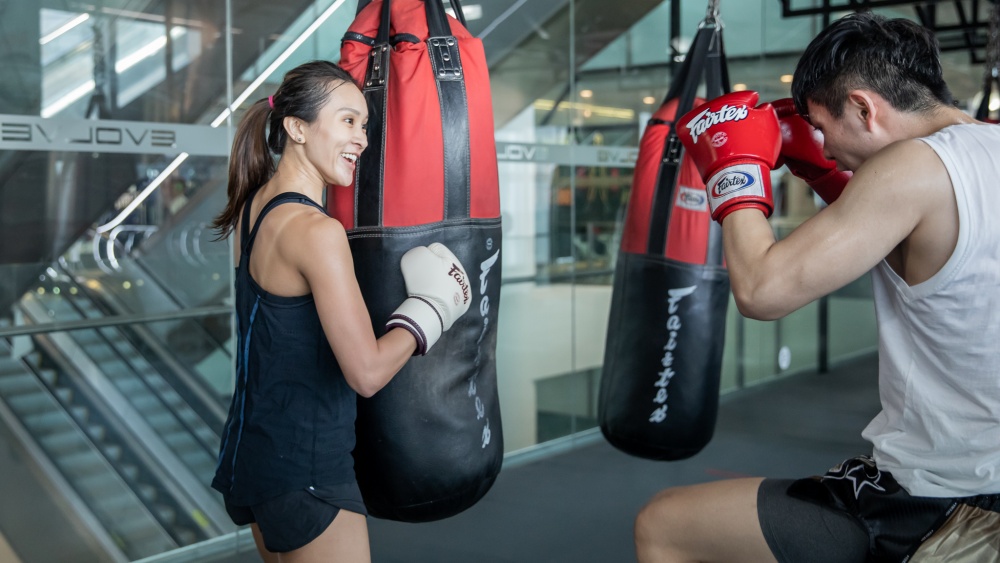
A good coach usually cultivates a gym with a welcoming environment and friendly training partners for you to practice with.
However, you need to consider more than just how friendly your teammates are when you commit to joining a gym.
It would be ideal if you can identify a good mix of skill levels among your new gym’s patrons.
As a beginner, it’s nice to train alongside others who are also starting out. That means you can share your martial arts journey and help each other out along the way.
At the same time, it’s still good to have some higher-level training partners. Training with people who are better than you will help your evolution as a martial artist because they’ll help you out and put you to the test when you’re ready to spar.
It’s also worth considering the size of your teammates. If you’re slight and hover around five feet tall, a gym populated by giants who measure over six feet and tip the scales at 100kg may not be for you.
While it’s not impossible to train with much bigger or smaller teammates, both you and your training partners will need to make big adjustments for pad work and sparring.
Some women may also prefer all-female classes, but this is not always possible at a lot of smaller gyms.
However, that shouldn’t put anyone off. Women’s participation in Muay Thai is growing all the time, so mixed classes are common, and most of the men are not half as scary as they look.
Equipment And Facilities
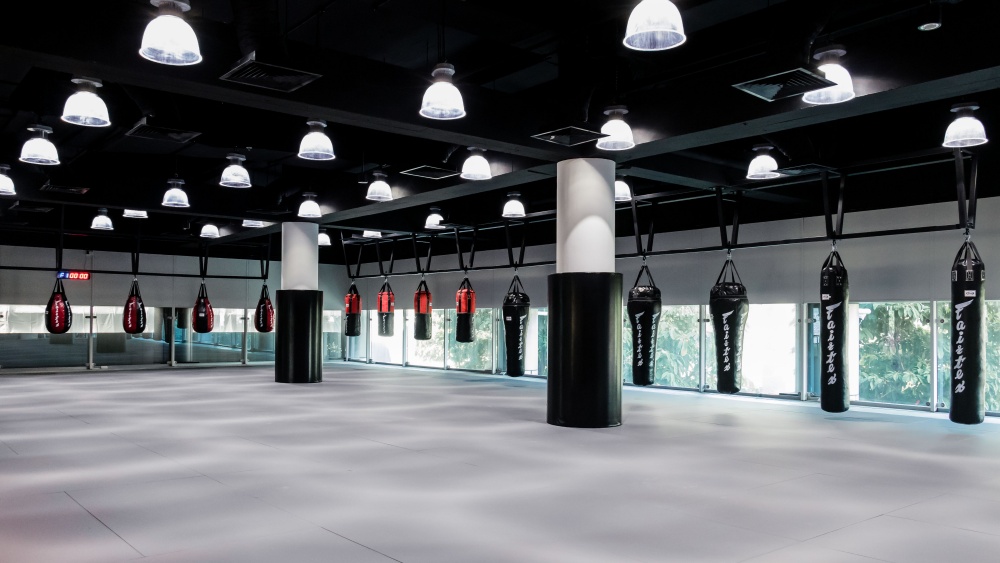
A gym full of brand new equipment is no substitute for quality in other areas.
Rows of heavy bags, a full-sized ring, and racks of brand-new mitts look great, but one coach with a sharp mind and a pair of Thai pads is far more effective than one who has all the gear, but no idea.
With that said, it’s a bad sign if the equipment is bursting at the seams and leather is peeling off all over the mats. If the gym owner doesn’t look after that, do you expect them to look after their students?
You can at least expect for there to be enough Thai pads to go around, and a few pairs of gloves to loan to beginners for their first few sessions.
However, you’ll want to quickly get your own stuff, because that second-hand kit smells really bad.
Your Goals
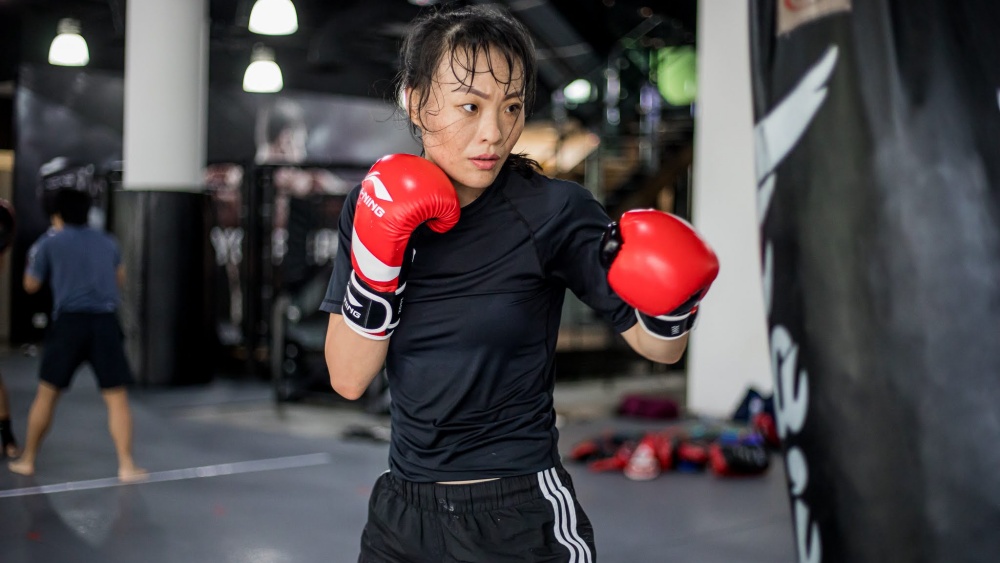
Finally, does the culture at the gym match up to what you want to get out of it?
By now, you’ll probably have established whether it’s a good place for beginners, but what about your plans beyond your first few weeks of training?
If you want to compete, ask whether that will be possible. If your gym is active in interclub competitions, regularly has fighters competing, or even promotes its own events, you’re in the right place.
You might also want to know if there’s an active social element among members. Muay Thai gyms are great places to make friends if you’re new to an area, so ask if there are regular events that everyone gets involved with.
Ready To Start?
We hope that we have answered all your questions in this comprehensive Muay Thai beginners guide! If you have yet to join the bandwagon of being a Muay Thai practitioner, we highly encourage you to get started today!
If you are in Singapore and looking for the best Muay Thai gym, consider joining us by signing up for a complimentary trial class now!
Book your complimentary trial class with our World Champions below!
If you have any other questions regarding Evolve MMA and the programs we offer, you can get in touch with our membership executives at the following locations:
Evolve MMA (Far East Square)
26 China Street
Far East Square #01-01
Singapore 049568
Phone: (65) 6536 4525
Evolve MMA (Orchard Central)
181 Orchard Road
#06-01 Orchard Central
Singapore 238896
Phone: (65) 6536 4556
Evolve MMA (KINEX)
11 Tanjong Katong Road
#02-52 KINEX
Singapore 437157
Phone: (65) 6288 2293
Evolve MMA (Clarke Quay Central)
6 Eu Tong Sen Street
#04-18 Clarke Quay Central
Singapore 059817
Phone: (65) 6226 2150
